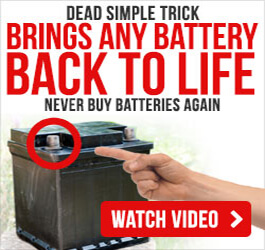There are several different types of batteries to choose from when creating a battery bank for your solar panel, wind turbine, or off-grid energy system…
And in this report, we’re going to compare lead-acid VS lithium-ion batteries – which are two of the most common batteries used in solar panel/off-grid energy systems…
Overview of Lead-Acid Batteries
Lead-acid batteries are considered the industry’s workhorse battery. They are extremely affordable, readily available, and rechargeable.
You will find this kind of battery in machinery, robotics, and any other type of system where weight is not important and plenty of power is needed. Lead-acid batteries come in 2V cells, meaning you can have a battery with an even voltage (2V, 6V, 12V, and 24V are the most common voltages).
Pros:
- Powerful
- Most affordable
- Easily rechargeable
- High potential power output
Cons:
- Low power density means batteries tend to be large bricks
- Quite heavy
Overview of Lithium-Ion Batteries
Lithium-ion batteries are the latest in rechargeable battery technology and have quickly become one of the most widely used batteries for electric cars and consumer electronics (such as cell phones, cameras, laptops, etc.).
Lithium-ion batteries are extremely lightweight, have a very high power density, and can tolerate high discharge rates.
The main caveat to lithium-ion batteries is they are more expensive, can be fragile, and require special circuitry. Thankfully, most lithium-ion batteries come with protection circuitry that keeps them operating safely.
Pros:
- High power output
- Very lightweight
- Large capacity
- High cell voltage
Cons:
- Expensive
- More fragile
- Slightly greater risk of fire (compared with lead-acid batteries)
How They Compare (more in-depth)
Both lead-acid and lithium-ion batteries are able to store energy effectively, but as you can see, each battery type has its own benefits and drawbacks. Let’s take a look at some important points of comparison.
Capacity
The capacity of a battery is a measure of how much energy it can store and eventually discharge. While the exact value for capacity will vary depending on make and manufacturer, lithium-ion batteries are known to have a significantly greater energy density than their lead-acid counterparts.
In essence, more energy can be stored within a lithium-ion battery using the same physical space. Since more energy can be stored in these batteries, more energy can be discharged, meaning that appliances and off-grid power systems can be powered for longer.
Cost
Lead-acid batteries outshine lithium-ion batteries in this category. Lead-acid battery banks can be hundreds or thousands of dollars cheaper than lithium-ion setups of similar sizes, with the latter generally costing between $5,000 and $15,000, including installation. These values can fluctuate based on the system size that you need.
Though lead-acid batteries usually have a lower cost in comparison to their lithium-ion counterparts, a typical lead-acid battery lifespan is a bit shorter than lithium-ion batteries (although regular maintenance and battery reconditioning on lead-acid batteries can dramatically improve their lifespan).
Efficiency
Just like you would compare the efficiency of different solar panels when you are considering which to purchase… battery efficiency is also an important measurement to take into consideration when comparing battery options.
Most lithium-ion batteries boast 95% efficiency or higher (meaning that 95% or more of the stored energy can be used effectively).
On the other hand, lead-acid batteries have efficiencies of around 80% to 85%.
Batteries with higher efficiencies charge quicker, and like the depth of discharge which we talk about in the next section, higher efficiency results in a greater effective battery capacity.
Depth of Discharge (DoD)
The depth of discharge of a battery is the percentage of a battery’s energy capacity that can safely be discharged while not causing any damage. For instance, if you have a battery that holds 13.5kWh of electricity, and you discharge 13kWh, the Depth of Discharge will be about 96%. DoD is an alternative method used to indicate a battery’s state of charge, and is a complement of the state of charge – as one increases, the other decreases.
Though it is common to use 85% or more of the total capacity of a lithium-ion battery in one cycle, lead-acid batteries should not be discharged further than about 50%. Doing so can negatively affect the battery’s lifespan.
Lithium-ion’s superior depth of discharge means that they boast an even greater effective capacity than lead-acid batteries, especially once you consider the greater energy density that lithium-ion batteries have.
Lifespan
Batteries deteriorate throughout their lifespan and become less effective with age (this is the reason your car battery isn’t able to start your car after years of use). Regular battery maintenance and reconditioning can greatly improve the lifespan of a battery but no battery lasts forever.
Using a battery to power your appliances or home, then charging it again, is considered a single ‘cycle.’
The average estimated lifespan for a lithium-ion battery is around 300 to 500 cycles, which equates to around two or three years (*note: a newer type of lithium battery called a Lithium Iron Phosphate battery (LiFeSO4) can now get 2,000 – 5,000 cycles if properly taken care of. They’re expensive but they have been steadily dropping in price. We’ll teach you more about these in other future blog posts and Members Only content).
And deep-cycle lead-acid batteries have lifespans of more than 1,000 cycles, even at Depth of Discharge over 50% (*however, battery reconditioning can increase the lifespan of both batteries).
Weight & Space
For many stationary battery bank installations, weight is generally not an issue, but if space is limited, remember that lead-acid battery banks are very heavy and need special racking systems for small areas. This means that they are not the best option for limited-space situations (like in an electric car), as they are quite large and require adequate ventilation to allow trace gases to escape while charging.
As we mentioned previously, lithium-ion batteries have a greater energy density, meaning they require far less space. They also do not emit volatile gases while charging and thus do not require the same level of ventilation as their lead-acid counterparts. You can store them in most non-habitable rooms with no problems.
So, Which Battery Type (lead-acid or lithium-ion) Should You Choose?…
Lead-acid and lithium-ion batteries will incur similar maintenance costs over the course of their lifespan, but when it comes to upfront costs, lithium-ion batteries are much more expensive.
So, if cost is your main concern, lead-acid batteries are the best option.
Lead-acid batteries are also a great option if you have plenty of space for a for a battery bank (like at your vacation home or off-grid cabin).
However, lithium-ion batteries may be the better choice if cost is not as much a concern and you want the “best” battery (and are willing to pay for it). Lithium-ion batteries are also the best option if you don’t want your battery bank to take up a lot of space or if you want to run your batteries really hard and constantly fully drain them and recharge them (*this is why lithium batteries are typically used in electronics and electric cars).
Lithium-ion batteries can be summed up by saying they last longer than many other types of batteries, can withstand being put through deeper cycles without being damaged, and require much less space compared to other batteries. However, you pay a lot extra for these benefits and you may not need these benefits.
One other thing to note about lithium-ion batteries is while the initial cost is significantly more than lead-acid batteries, the cost difference closes a bit over the lifespan of the battery because their added efficiency means you can potentially spend less per kWh of capacity over the battery’s lifespan. But with that being said, when everything is said and done, lithium-ion batteries still typically end up costing more after their full life cycle (compared to lead-acid batteries).
So with that being said, we hope you found this guide very helpful when choosing between Lead-Acid Batteries and Lithium-Ion Batteries in your solar panel, wind turbine, or off-grid energy system.
Good luck building your system’s battery bank!
You may also like:








2 replies to "Lead-Acid Batteries VS Lithium-Ion Batteries (Which is Better To Use In Your Solar Panel or Off-Grid Energy System?) (direct)"
Really helpful article. I’m choosing between these two battery types right now for my solar panel system. Thank you!
This was really helpful. I’ve been debating between lead-acid and lithium-ion batteries. The pros and cons in this article were great.